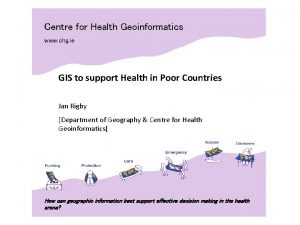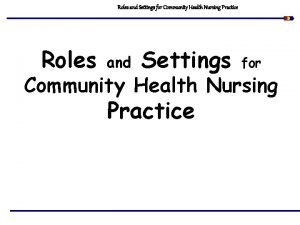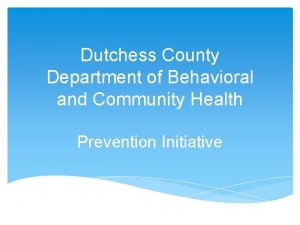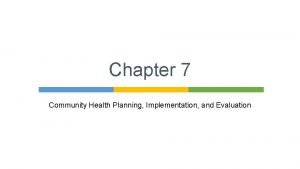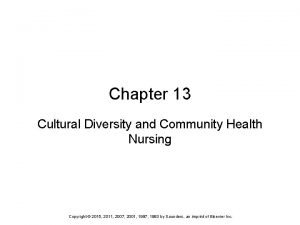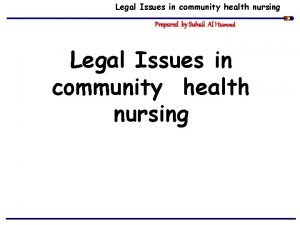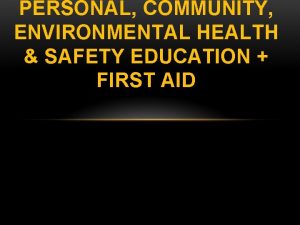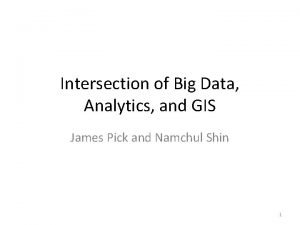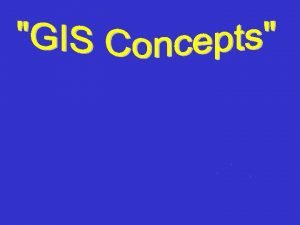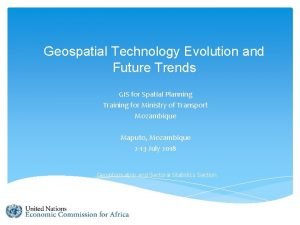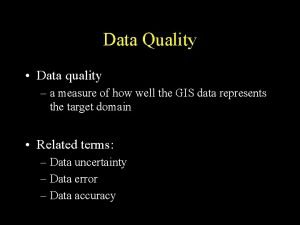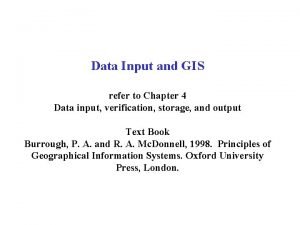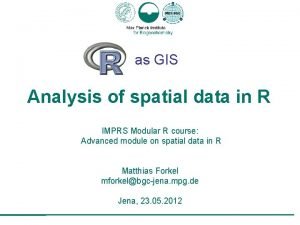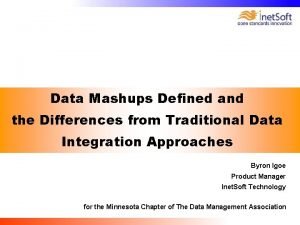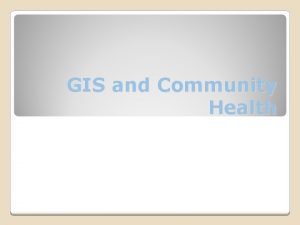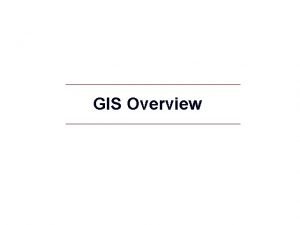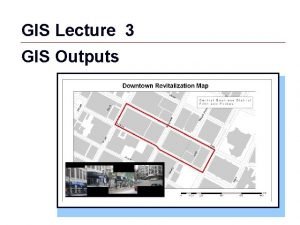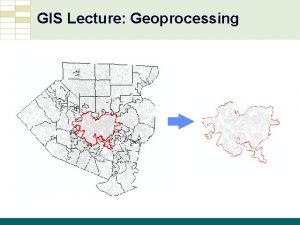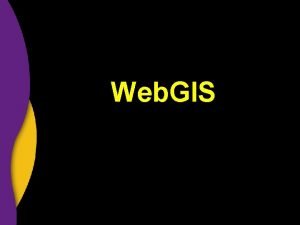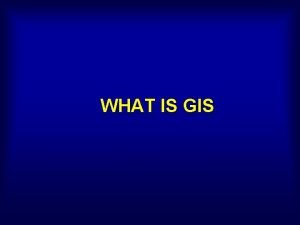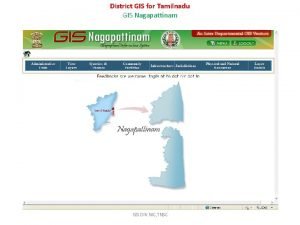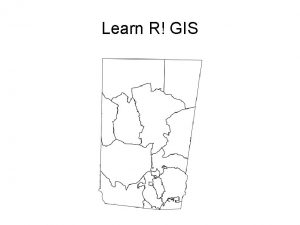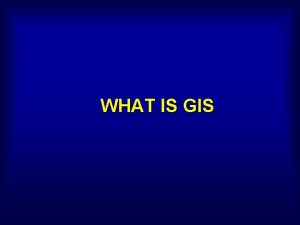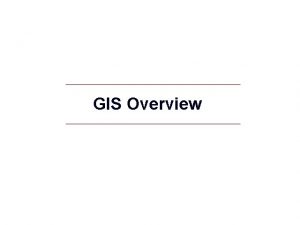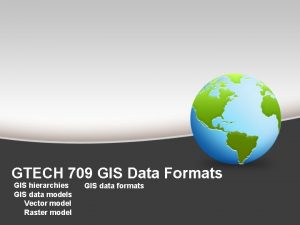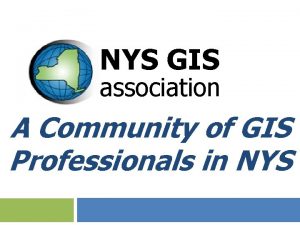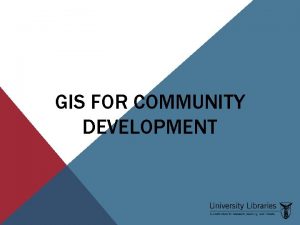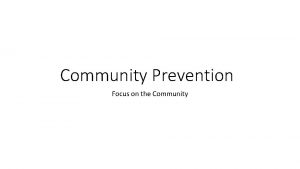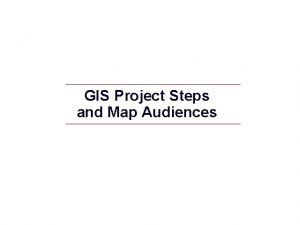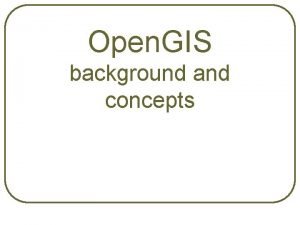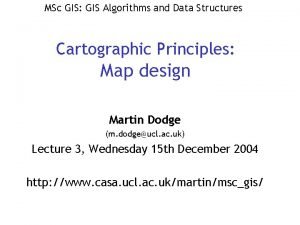GIS and Community Health GIS and Community Health























- Slides: 23

GIS and Community Health

GIS and Community Health Some critiques of GIS emphasize the potentially harmful social consequences of the diffusion of GIS technology, including reinforcing the power of state agencies, facilitating surveillance, and promoting an at best – naive, technocratic view of social problems (Goss, 1995; Sheppard, 1995; Campbell, 1996; Clark, 1998)

GIS and Community Health At the same time, the development of GIS and the hardware, software, databases, and networking systems they rely on have also made it possible for the general public to have greater access to health and environmental information and to visualize and analyze that information in new and innovative ways.

Institutional Context and Interests in GIS Development o o o A range of institutions and organizations have adopted GIS as an information technology. These organizations have different program responsibilities and information needs, and as a consequence different reasons for using GIS The institutional context affects the kind and quality of geographic data available for GIS implementation.

Institutional Context and Interests in GIS Development o o Federal and state agencies develop foundation databases for their own use and public distribution Data vary from place to place depending upon geographical conditions, state agency responsibilities, and state regulatory requirements Local agencies and community groups have access to detailed information about local conditions Databases developed by private concerns may be very detailed but are less likely to ve available for public distribution

Institutional Context and Interests in GIS Development Data § Institution Collection. IManagement. IAnalysis. IDistribution. IRegulation. IScientific Research Federal agencies State agencies Local agencies Health care Providers and Insurers Universities Research institutes Libraries and Clearinghouses GIS vendors Community Groups x x x x x x x x

Institutional Context and Interests in GIS Development cont… Institution Education and training. IAdvocacy. IHealth service delivery. ISoftware development Federal agencies State agencies Local agencies Health care Providers and Insurers Universities Research institutes Libraries and Clearinghouses GIS vendors Community Groups x x x x x

(PPGIS) Public Participation GIS o The expanding role of GIS in community-based health initiatives is connected to the broader movement to develop public participation GIS, linking the various institutions and organizations involved in GIS development

(PPGIS) Public Participation GIS o Systems that facilitate and enhance participation of individuals and groups in society around issues of local concern (Sheppard, 1999) The systems enable participants to explore local environmental and social issues, asses their significance, and communicate openly and effectively in attempting to address those issues.

Corner stones of PPGIS o o o To accommodate an equitable representation of diverse views This implies enhancements to GIS design and functionality, as well as understanding of the sociopolitical contexts of community participation A key element of PPGIS is community involvement in the creation, evaluation, and analysis of spatial data.

Corner stones of PPGIS o Local knowledge in the form of narratives, photos. Sketch maps, or video images that may be linked to and integrated with foundation spatial data. Some GIS are now able to handle such diverse types of spatial information

Corner stones of PPGIS o o Web based GIS hold great promise for development of PPGIS. In PPGIS, participant involvement also extends into analysis and interpretation of spatial data PPGIS can be designed in different ways depending on the needs and goals of participants, along with technical and social constraints.

Corner stones of PPGIS o A more flexible approach allows participants to design their own queries, create new classifications, and even contribute data to the GIS; however, using these systems requires higher levels of skill and expertise on the part of community participants

Corner stones of PPGIS o PPGIS differ in the involvement of key interest groups or stakeholders. Because maintaining and operating GIS requires technical expertise, most PPGIS involve partnerships between community groups and academic researchers, students or trained public health professionals.

GIS Access and Education for Community Groups o GIS and the Internet are supporting public distribution of foundation data layers n US Bureau of Census n Land View III( The Bureau of Census, EPA, the U. S. Geological Survey, the Nuclear Regulatory Commission, Dept. of Transportation and FEMA) n HUD produced Community 2020, a low priced desktop GIS

Libraries and GIS o Spatial data in five categories n n n Scanned map images Spatial database libraries and their catalogs Map generators Map browsers Real-time maps and images

Libraries and GIS o o The ARL GIS Literacy project supported a range of GIS applications in research libraries The New York State Library in Albany hosts New York State GIS Clearinghouse

Libraries and GIS o Fulfill a critical role in archiving and maintaining collections of digital geospatial data as the databases are replaced by updated versions.

GIS in the Schools o o o GIS technology into K-12 education Access to hardware and time constraints in the learning day are critical factors affecting the incorporation of GIS into K-12 curriculum Teacher training workshops and surveys designed to help educators assess GIS readiness are being used to encourage the diffusion of GIS technology into the public schools

Local Planning o o Grassroots GIS efforts involve citizens more directly in mamaging their communities Broader community awareness of GIS and access to technology

Community-based public health GIS o o o Difficult to review Usually deal with specific, localized communities, seek to document a wide range of neighborhood conditions, reflecting a broad view of health GIS adapted by local groups as a tool to raise community awareness of neighborhood conditions and available services, to organize local residents, and ultimately to effect change

Constraints on PPGIS o o o Differences in community resources and capacity to adopt GIS technology GIS represents a significant investment of money, time and staff, an investment that competes with other important needs for scarce community resources Communities that lack resources and political cloud are less likely to benefit from participatory health GIS

Constraints on PPGIS o o Little is known about the performance and outcomes of PPGIS in diverse communities and the varying capacities of diverse groups to ensure that their health interests and needs are addressed. PPGIS facilitate community participation in analyzing local health problems, but do not guarantee that those problems will be addressed.
 Occupational health nurse roles and responsibilities
Occupational health nurse roles and responsibilities Who gis centre for health
Who gis centre for health Prepare to scale up in community mobilization
Prepare to scale up in community mobilization Family and community health advisor
Family and community health advisor Role of chn
Role of chn Dutchess county behavioral and community health
Dutchess county behavioral and community health Community health planning and implementation
Community health planning and implementation Chapter 13 cultural diversity and community health nursing
Chapter 13 cultural diversity and community health nursing Larry davidson yale
Larry davidson yale Ethical and legal issues in community health nursing
Ethical and legal issues in community health nursing Duke medicine grand rounds
Duke medicine grand rounds Personal community and environmental health
Personal community and environmental health Health and social care component 3
Health and social care component 3 Big data gis
Big data gis What is raster and vector data in gis
What is raster and vector data in gis Gis grid station
Gis grid station Data entry in gis
Data entry in gis Gis evolution and future trends
Gis evolution and future trends Micro and macro components of accuracy
Micro and macro components of accuracy Gis data input
Gis data input R for gis
R for gis By gis and by saint charity
By gis and by saint charity I dare damnation
I dare damnation Mashups meaning
Mashups meaning

